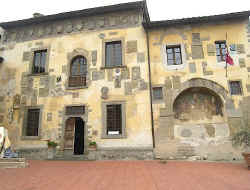
|
Anghiari Castles and Villas |
As in many of the long-populated areas of Tuscany, there are a number of fine castles and castellated villas in the vicinity of Anghiari. These fortified dwellings defended the Upper Tiber Valley (Valtiberina) and the valleys that led into it along the lines of attack that connected Arezzo to the Adriatic Sea. Along the right-hand side of the Sovara valley, there are Valialle, which goes back to before 1000 AD but of which only a few traces of the walls remain, Casale, Upachi, with its recently renovated church, and Scoiano, where much remains, including a stone doorway and traces of frescoes that indicate an important past. |
Scoiano
Villa La Barbolana |
|
|
|
The fortified Villa La Barbolana was constructed between 1565 and 1582 for Federico di Antonio Barbolani. It is an
unusual square villa with bastions that jut out slightly on each corner and a particularly tall central tower. Is surrounded by a moat with two bridges giving access.
Inside there are vaulted ceilings, terracotta floors and renaissance stone door
frames and on the ground floor there is a small 18 C chapel. |
Castello dei Sorci |
|
|
|
In 1268 the Castle of the Sorci was destroyed by the German forces of Corradino of Swabia who was fighting against Carlo of Angiò. It subsequently came under the control of Florence and became the home of the Mercenary Captain, Baldaccio d'Anghiari. At one time there were up to thirty men-at-arms guarding its moated walls. Over the following centuries the castle, like many during the peace that Florentine domination provided, was gradually converted into fortified villa incorporating the original tower. The castle took on its present aspect in the 17 C and today houses a quite famous restaurant. |
The Lombard Fort of Toppole |
|
Toppole Castle was another part of the fortification system that defended the right hand side of the Sovara valley.
The earliest documentation shows Enrico di Barnabò of the Lombards of Galbino defending Toppole
on behalf of the Abbey of Santa Flora of Arezzo. In 1142, the castle was given to the monks of Camaldoli together with a part of the castles of Pianettole and
Valialle. Toppole was granted to Anghiari by Raniere of Galbino and it then followed the same fortunes as all the towns and villages of the
Upper Tiber Valley until they came first under the dominion of Guido Tarlati of Arezzo and then of Florence. |
|
Pianettole |
|
Pianettole is in a fairly good state of repair and thus represents a nice example of a
mediaeval fortified habitation with a high, encircling stone wall and a tower guarding the west facing gateway. |
|
Castle of Montauto |
|
Montauto was already in existence during the period of the Etruscans (approximately 8th to 5th centuries BC ),
who took advantage of the rich copper mines in its territory. It was a Roman and
then Byzantine lookout tower and came under the control of the feudal Lord
Goffredo, son on Ildebando, to whom Emperor Otto I conferred the property in the
Upper Tiber Valley in 967 AD. The castle itself has its origins in 1170/80 which is the period in which the Lords of Montauto are first mentioned as the feudal rulers. |
|
Castello di Galbino |
|
The Castle of Galbino is located between the Sovara river and the Libbia main road,
and was part of the feudal domain of Conte Ranieri and can therefore trace its origins back at least to the year 1000.
The castle was subsequently converted into a private residence, and now has a basic square shape with a raised central section and four round towers on the corners.
Elegant arched loggias with stone columns, added during its renaissance period conversion, run along two sides. |
|
|
Anghiari Castles and Villas |
Anghiari © ammonet InfoTech 2007 - 2020